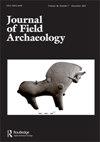古代女性:性别分析与全球考古学期刊发表
IF 1.5
1区 历史学
0 ARCHAEOLOGY
引用次数: 1
摘要
摘要考古出版研究表明,男性和女性作者的比例一直不平衡。我们利用提交的材料和编辑决策数据(2015-2020)对世界考古杂志《古董》进行了分析。我们确定了每两位男性作者中就有一位女性的复发率,包括所有列出的作者、单独和首次命名的作者以及团队作者。然而,按通讯作者的国家和地区对作者性别进行分类,揭示了巨大的差异,为理解全球考古学出版趋势开辟了一条新途径。我们还评估了与作者性别相关的同行评议和编辑决策,没有发现偏见的证据,并使用2020年的数据,寻找新冠肺炎对性别的任何潜在影响,发现单身女性作者可能比团队中的作者更受影响。我们将研究结果与作者多样化的举措联系起来,包括早期职业研究人员的能力建设项目。本文章由计算机程序翻译,如有差异,请以英文原文为准。
Women in Antiquity: An Analysis of Gender and Publishing in a Global Archaeology Journal
ABSTRACT Studies of archaeology publishing demonstrate a persistent imbalance in the ratio of male and female authors. We present an analysis of the world archaeology journal Antiquity using submissions and editorial decisions data (2015–2020). We identify a recurrent ratio of one female for every two male authors across measures including all listed authors, solo and first-named authors, and team authorship. Disaggregating author gender by country and region of corresponding author, however, reveals substantial variation, opening a new avenue for understanding of global trends in archaeology publishing. We also assess peer review and editorial decision-making in relation to author gender, finding no evidence of bias and, using the 2020 data, we look for any potential gendered impact of Covid-19, finding solo female authors may have been more affected than those working in teams. We contextualize the results in relation to initiatives to diversify authorship, including capacity-building programs for early career researchers.
求助全文
通过发布文献求助,成功后即可免费获取论文全文。
去求助
来源期刊

JOURNAL OF FIELD ARCHAEOLOGY
ARCHAEOLOGY-
CiteScore
4.60
自引率
5.30%
发文量
29
期刊介绍:
The Journal of Field Archaeology is an international, refereed journal serving the interests of archaeologists, anthropologists, historians, scientists, and others concerned with the recovery and interpretation of archaeological data. Its scope is worldwide and is not confined to any particular time period. Contributions in English are welcomed from all countries.
 求助内容:
求助内容: 应助结果提醒方式:
应助结果提醒方式:


